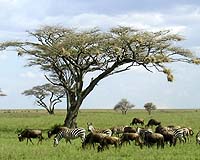| . |  |
. |
Raleigh NC (SPX) Sep 17, 2010 A multinational team that includes a North Carolina State University researcher has found another piece of the atmospheric puzzle surrounding the effects of aerosol particles on climate change. Their findings will contribute to our ability to more accurately measure human impact on climate, and to determine how much pollution may "mask" the actual rate of climate change. Dr. Markus Petters, an NC State assistant professor of marine, earth and atmospheric sciences, traveled to the Amazon rainforest in a remote area of Brazil as part of a team that wanted to study how a rainforest behaved in the absence of any anthropogenic, or human, influence. They were particularly interested in the behavior of atmospheric aerosol particles, which play an important role in our climate system due to their ability to modify cloud formation and encourage or suppress precipitation. Aerosol particles act as seeds for cloud formation and water condensation inside clouds. Some of these particles - about one in a million - form ice crystals inside the clouds, which initiate rainfall. In areas populated by humans, pollution serves as an additional source for these particles. In a pristine area such as the Amazon, where pollution is not a factor, the researchers found that the rainforest itself acted as a biogeochemical reactor, producing "fuel" for the rainclouds from organic molecules emitted by trees, as well as other biological matter such as plant debris, bacteria and pollen. "The trees basically 'sweat out' organic molecules that react with compounds in the atmosphere, producing tiny particles that are around 20 to 200 nanometers in size," Petters says. "These particles seed the clouds. In addition, other biological particles form the ice nuclei for the clouds." "We have to look at areas without anthropogenic influences and see what the aerosol budget is like without humans being involved," Petters says. "The Amazon is unique in that it provides a good place for us to observe atmospheric interactions without human influence, and to catalog baseline activity for the rainforest. If we understand that baseline well enough around the world, we can run simulations that show how human aerosol emissions modulate climate change."
Share This Article With Planet Earth
Related Links North Carolina State University Forestry News - Global and Local News, Science and Application
 Highway plan would destroy Serengeti: biologists
Highway plan would destroy Serengeti: biologistsParis (AFP) Sept 15, 2010 Plans to drive a 50-kilometre (31-mile) two-lane highway into Tanzania's Serengeti would destroy one of the world's last great wildlife sanctuaries, top biologists warned on Wednesday. "The road will cause an environmental disaster," 27 biodiversity experts said in a commentary published by the science journal Nature. They urged the Tanzanian government to look at an alternative route th ... read more |
|
| The content herein, unless otherwise known to be public domain, are Copyright 1995-2010 - SpaceDaily. AFP and UPI Wire Stories are copyright Agence France-Presse and United Press International. ESA Portal Reports are copyright European Space Agency. All NASA sourced material is public domain. Additional copyrights may apply in whole or part to other bona fide parties. Advertising does not imply endorsement,agreement or approval of any opinions, statements or information provided by SpaceDaily on any Web page published or hosted by SpaceDaily. Privacy Statement |